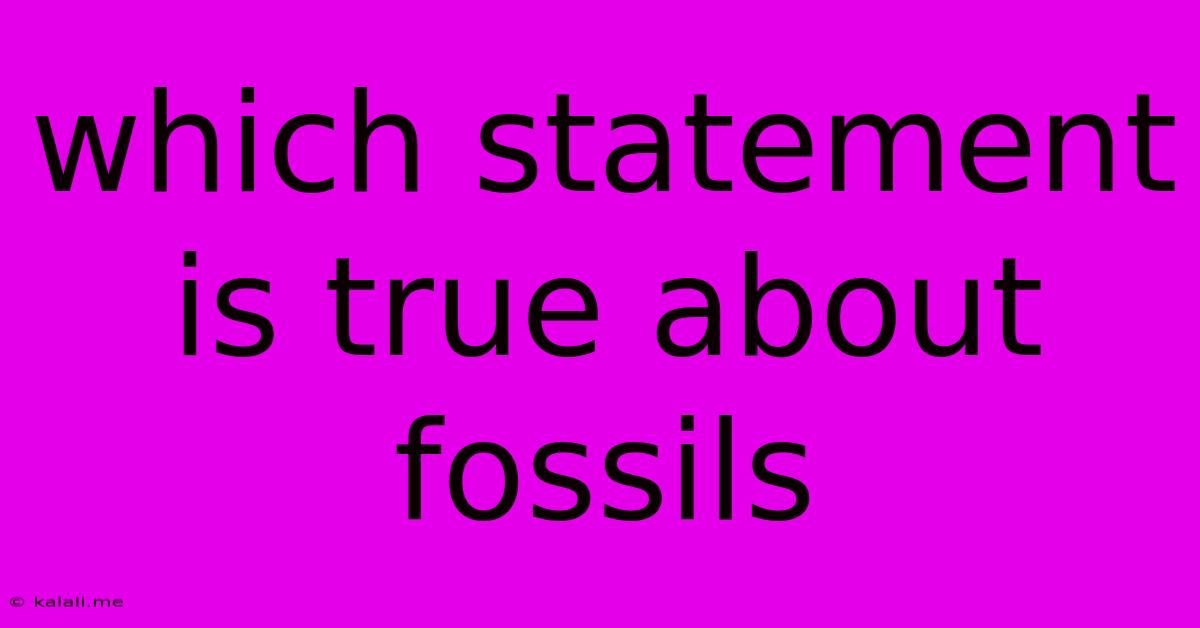Which Statement Is True About Fossils
Kalali
Jun 15, 2025 · 3 min read

Table of Contents
Which Statement is True About Fossils? Unveiling the Secrets of the Past
Fossils: remnants of ancient life preserved within the Earth's crust. They offer a captivating glimpse into our planet's rich history, revealing the evolution of life and the environments that shaped it. But what exactly is true about these incredible records of the past? This article will explore several common statements about fossils and determine their accuracy, helping you better understand these fascinating artifacts.
Key takeaway: Fossils are not just bones; they represent a wide range of preserved organic material, providing invaluable insights into past ecosystems and the history of life on Earth. Understanding the various types of fossilization processes is crucial to interpreting the fossil record accurately.
Statement 1: Fossils are always bones or skeletons. FALSE
While fossilized bones and skeletons are certainly common and often spectacular, this statement is a vast oversimplification. The process of fossilization can preserve a wide variety of organic materials. This includes:
- Petrified wood: Where the organic material of the wood is replaced by minerals, preserving the original structure.
- Trace fossils: These aren't the organism itself, but evidence of its activity, such as footprints, burrows, or even fossilized feces (coprolites). They provide crucial information about behavior and environment.
- Imprints: These are impressions left behind by organisms, like leaf imprints in sedimentary rock.
- Amber: Insects and other small organisms can be perfectly preserved in fossilized tree resin.
- Molds and casts: These form when an organism decomposes, leaving behind a cavity (mold) that can later be filled with minerals (cast), creating a three-dimensional replica.
Statement 2: Fossils are only found in sedimentary rock. MOSTLY TRUE
Sedimentary rocks, formed from layers of sediment accumulating over time, are the most common location for fossil discovery. The slow burial process in sediment is crucial for preservation. However, fossils can sometimes be found in other rock types, such as metamorphic rocks that have undergone changes in pressure and temperature, or even volcanic rock under specific circumstances. The conditions for preservation must be exceptionally favorable in these instances.
Statement 3: The fossil record is complete and shows the entire history of life on Earth. FALSE
The fossil record is notoriously incomplete. Fossilization is a rare event, requiring specific conditions for preservation. Many organisms decompose before they have a chance to become fossilized, leading to gaps in the record. Additionally, erosion and geological processes can destroy existing fossils. While the fossil record is incomplete, it remains our most valuable source of information about the history of life. Scientists continue to refine our understanding by studying new discoveries and improving dating techniques.
Statement 4: Fossils are always millions of years old. FALSE
While many fossils are indeed millions of years old, some are relatively recent. For instance, organisms that died only a few hundred years ago can become fossilized under the right conditions. The age of a fossil depends entirely on its geological context and can range from relatively young to incredibly ancient.
Statement 5: Studying fossils helps us understand evolution. TRUE
The fossil record is crucial for understanding the process of evolution. Fossils provide direct evidence of past life forms and how they have changed over time. By studying the sequence of fossils, scientists can trace evolutionary lineages and identify transitional forms that demonstrate the gradual changes between species. The fossil record isn't a perfectly smooth narrative, but it offers compelling evidence supporting the theory of evolution.
In conclusion, understanding what is and isn't true about fossils is key to appreciating their significance in unraveling Earth's history and the evolution of life. The fossil record, while incomplete, offers a remarkable window into the past, constantly challenging and expanding our knowledge of the natural world.
Latest Posts
Latest Posts
-
80 Of X Is Equal To 100
Jun 15, 2025
-
What Are The First Five Multiples Of 5
Jun 15, 2025
-
What Is The Coefficient Of Discharge
Jun 15, 2025
-
Consider Steady State Conditions For One Dimensional Conduction
Jun 15, 2025
-
Difference Between High Pass And Low Pass Filter
Jun 15, 2025
Related Post
Thank you for visiting our website which covers about Which Statement Is True About Fossils . We hope the information provided has been useful to you. Feel free to contact us if you have any questions or need further assistance. See you next time and don't miss to bookmark.